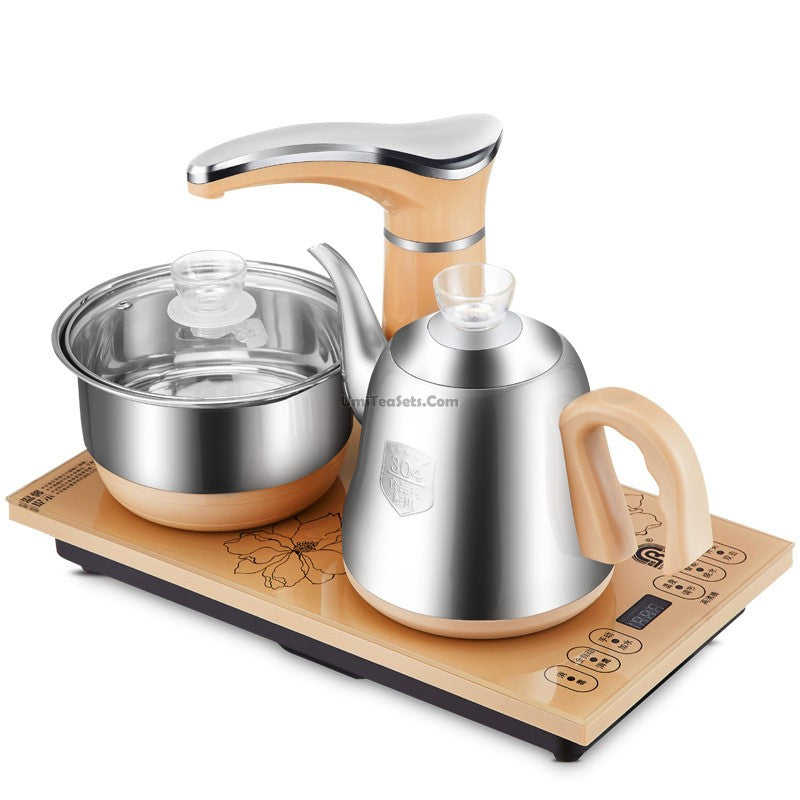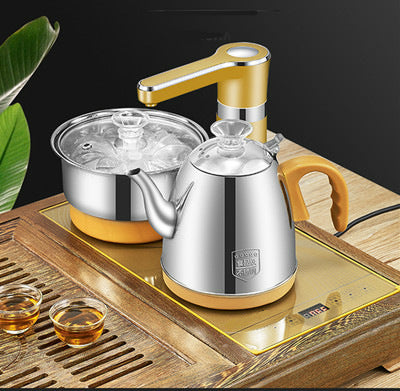3 products
-
Glass Teapots With Golden Induction Cooker
 Vendor:Glass Teapots With Golden Induction CookerUmi Tea Sets
Vendor:Glass Teapots With Golden Induction CookerUmi Tea Sets- Regular price
-
$133.96 USD - Regular price
-
- Sale price
-
$133.96 USD
Quick view
-
Stainless Steel Teapot With Black Induction Cooker (110V)
 Vendor:Stainless Steel Teapot With Black Induction Cooker (110V)Umi Tea Sets
Vendor:Stainless Steel Teapot With Black Induction Cooker (110V)Umi Tea Sets- Regular price
-
$138.98 USD - Regular price
-
- Sale price
-
$138.98 USD
Quick view
-
Stainless Steel Teapot With Golden Induction Cooker
 Vendor:Stainless Steel Teapot With Golden Induction CookerUmi Tea Sets
Vendor:Stainless Steel Teapot With Golden Induction CookerUmi Tea Sets- Regular price
-
$111.57 USD - Regular price
-
- Sale price
-
$111.57 USD
Quick view
What is Electric Teapots?
The electric teapots were born in Chicago in 1891. With the development of science and technology, fast, safe, convenient, and full use of energy have gradually become the main features of the kettle, and the British people who like tea from then on and fell in love with it. In the 21st century, it has become a global bestseller. The electric teapot adopts the steam intelligent induction temperature control, which has the function of automatically powering off after the water boils, and preventing dry heating.
Types of Electric Teapots
1. Whistle Type Electric Teapots.
When the water temperature reaches above 100 ℃, the air flow whistle will warn. Because there is no temperature limiting controller for this kind of teapot, the power supply must be turn off manually. This kind of electric teapot has the advantages of simple structure, lower price, and is widely used in residents' families.
2. Anti Dry Burning Whistle Electric Teapots.
When the water level in the teapot is lower than that of the electric heating tube (the temperature of the electric heating tube exceeds 100 ℃), the automatic constant temperature control switch will automatically turn off the power supply to protect the electric teapot from being burned.3. Plastic Electric Teapots
The biggest characteristic of plastic electric kettle is easy to carry, safe and reliable. This new type of electric kettle adopts a hidden stainless steel electric heating plate, and is equipped with a steam induction control switch. It has multiple protection functions, such as automatic power-off, anti dry burning power-off, thermal fusing electric protection and grounding protection.
Advantages of Electric Teapots
1. Fast heating
"Fast heating" is the most basic requirement of stainless steel electric teapot. Therefore, the original heating coil has been transformed into a wider and thicker heating chassis. On the one hand, it is more beautiful and practical, and it has solved the problem that scale is difficult to clean; on the other hand, it is more effective in heating. It can boil a liter of water to boiling in 3-5 minutes, and you can also keep it in different temperatures.
2. Great Heat Preservation Effect.
Our electric teapots uses high-quality temperature controller as the key component. It would make sure the water is fully boiled and can be completely sterilized. This change makes electric teapots no longer only a tool for boiling water, but also a tool for storing water.
How to Select Electric Teapot?
1. According to their own situation and actual needs, a 1.0L~1.2L teapot can be used for families with 2-3 members, a electric teapot about 1.8L can be used for 4-5 people.
2. Check the mark and description carefully, as well as the performance and parameters of the product, such as the specification (such as capacity), model, trademark, voltage parameters, power parameters, power supply nature, etc.; there should be warning words to prevent misuse and detailed usage methods.
3. When selecting electric teapots, it is better to check whether the electric teapots have relevant certification marks. Such as "CCC" certification mark.
4. The new electric teapots has the function of temperature control. When the water boils, it will turn off automatically. It can effectively prevent dry burning caused by unattended and avoid all kinds of accidents.

Notices
1. The rated power of electric teapot is large. The capacity of power plug, socket and power line should be selected appropriately. Generally, 10A specification should be selected. If the rated power exceeds 2200W, larger size socket should be used. In addition, these sockets should be used independently to ensure safety.
2. The plug of the electric teapot has a grounding pole and should be connected to a socket with a grounding socket. When in use, the power plug should be fully inserted into the socket.
3. You should keep the power plug, socket, power cord and automatic switch device dry and clean.
4. The water should not exceed the maximum water level to prevent the liquid from overflowing out of the teapot when boiling. Water also should not be too less, otherwise it may cause dry heating, especially the whistle type electric teapot. In addition, pay attention not to connect the power supply before filling water, otherwise it is easy to burn out the heater or cause dangerous accidents.
5. Please don't put it in the place where the children can touch, and pay attention not to let the children play, which may cause scald.
6. To avoid scalds caused by boiling water, you should unplug the plug first, turn off the power supply, and then use boiling water to ensure safety.
7. The electric teapot should not be immersed in water or rinsed with water when cleaning, so as to avoid damage to the electrical insulation due to moisture and cause fault and leakage.
8. When using the electric teapot to brew tea, the spout is not appropriate for the guests.
How to Clean the Electric Teapot?
Although electric teapot will not rust, it will inevitably grow scale. If the scale is not cleaned for a long time, it will greatly increase the heating time of boiling water, thus wasting more power resources. However, how to remove the scale of stainless steel teapot is disturbing for everyone. Here are some methods to remove scale:
1. Vinegar descaling. This method is the simplest and most practical method. Everyone knows that the main components of scale are carbonates and other calcium carbonate. The acetic acid in the vinegar will react with it to produce minerals and carbon dioxide gas that are dissolved in water. You can buy white vinegar in supermarkets, add 10% of the white vinegar on the scale of the kettle, fill it with water, let it boil for about an hour, and then scrub it. Black vinegar is fine, but it is not as effective as white vinegar.
2. Cooking yam to remove scale. Put more than half a teapot of yam, add water, cook the yam and heat the water, there will be no water scale then in future use. But we should pay attention to the inner wall of the pot after boiling yam, otherwise it will lose the function of descaling. For the old teapot which has been full of scale, the original scale will gradually fall off after being boiled once or twice with the above method, and it can prevent the scale from accumulating again.
3. Remove scale with baking soda. Generally, electric teapots are easy to form scale when boiling water. You can put 1 teaspoon of baking soda and boil for a few minutes to remove the scale. Or can also pour into the concentration of 1% of bicarbonate water about 500 g, gently shake rinse, scale can be removed.
4. Boil eggs to remove scale. Generally, electric teapot is hard and hard to remove scale after a long time of use. If you use it to cook eggs twice, you will get an ideal effect. Break the two eggshells slightly, put them into the teapot, then put half a pot of water, stir with a blender or spoon, and then boil, place for about half an hour, pour out the eggshell, and then rinse twice with water.
5. Removing scale with lemon. Buy a slice of lemon and cook it in an electric teapot. After boiling, place it for a while. When the water become cool, pour it out again to remove the scale inside. This method is more reliable, but also very convenient and healthy.
How to Nourishing Your Electric Teapot?
1. In order to prolong the service life of the teapot, the mineral deposits in the teapot should be cleaned regularly.
2. Be sure to disconnect the power supply first when you cleaning.
3. Pour vinegar and water into the teapot according to the ratio of 1:2, then turn on the power, let the teapot work and wait for it to automatically turn off.
4. Let the mixture be stored in the teapot for 24 hours, then pour out the mixture, and then put water into it, and then work.
5. Pour out the water and the scale and vinegar will be taken away. Finally, clean the inside of the teapot with clean water. If necessary, please repeat the above operation.
6. In the process of using the electric teapot, if it doesn't work, take the teapot out of the heating chassis, pour out the water in the teapot, and then let it cool to normal temperature before fault detection or cleaning.
Brew Tea
Nice tea needs good water and appropriate temperature. Water temperature directly affects the water-soluble substances in tea and the degree of evaporation of the aroma.
The three--boiling water theory
About water, Lu Yu, the first to propose the three-boiling theory, said: "the first boiling begins when the hot water makes little bubbles and low noise; the second boiling begins when the hot water generates continous bubbles; the third boiling begins when the hot water has rolling waves. The second boiling water is the most adapted water for brewing tea; water after three times of boiling can not be drunk.
Lu Yu divided the boiling water into three specific stages, ,which affected the tea tasting in the Tang, Song, Ming, and Qing Danasties. It is also very important to us today.However, in reality, we usually use the electric kettle to boil water; the fire's size has been designed, so it is hard to master the timing of the second boiling. But we should not let the water boil for long, for that will make the tea color dark, bitter; which not only affects the quality of tea, but also the health.
So, if you want to get the best "second boiling" water, ,it needs careful operation, while we must pay attention to boiling water in a big fire and quick boiling instead of small fire and long boiling.
The ancients: cook tea with dew
About the water in cooking tea, Emperor Qianlong is very particular about it. He wrote a poem, in which the described how he cooked tea using the dew collecting from the lotus leave.
There was a short preface before the poem. In it, he said, the lighter the water is, the better the water is. Snow water and dew are lighter than spring water, however, snow water cannot be often got, so dew is the best choice during the summer and autumn.
When Chinese people make tea, they are very particular about the water-boiling. Su Dongpo, a well-known poet, he said if you can not boil water properly, then you can not get nice tea.

